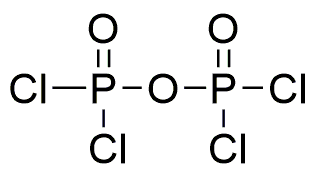Diphosphoryl chloride is widely utilized in research focused on:
- Synthesis of Phosphoryl Compounds: It serves as a key reagent in the synthesis of various phosphoryl compounds, which are essential in pharmaceuticals and agrochemicals.
- Phosphorylation Reactions: This chemical is crucial for introducing phosphate groups into organic molecules, enhancing their biological activity, particularly in drug development.
- Production of Flame Retardants: It is used in the manufacturing of flame retardant materials, providing safety benefits in textiles and plastics.
- Research in Biochemistry: Diphosphoryl chloride plays a role in biochemical research, particularly in studying enzyme mechanisms and signaling pathways.
- Development of Advanced Materials: Its application in creating advanced materials, such as coatings and adhesives, offers improved durability and performance compared to traditional compounds.
General Information
Properties
Safety and Regulations
Applications
Diphosphoryl chloride is widely utilized in research focused on:
- Synthesis of Phosphoryl Compounds: It serves as a key reagent in the synthesis of various phosphoryl compounds, which are essential in pharmaceuticals and agrochemicals.
- Phosphorylation Reactions: This chemical is crucial for introducing phosphate groups into organic molecules, enhancing their biological activity, particularly in drug development.
- Production of Flame Retardants: It is used in the manufacturing of flame retardant materials, providing safety benefits in textiles and plastics.
- Research in Biochemistry: Diphosphoryl chloride plays a role in biochemical research, particularly in studying enzyme mechanisms and signaling pathways.
- Development of Advanced Materials: Its application in creating advanced materials, such as coatings and adhesives, offers improved durability and performance compared to traditional compounds.
Documents
Safety Data Sheets (SDS)
The SDS provides comprehensive safety information on handling, storage, and disposal of the product.
Product Specification (PS)
The PS provides a comprehensive breakdown of the product’s properties, including chemical composition, physical state, purity, and storage requirements. It also details acceptable quality ranges and the product's intended applications.
Certificates of Analysis (COA)
Search for Certificates of Analysis (COA) by entering the products Lot Number. Lot and Batch Numbers can be found on a product’s label following the words ‘Lot’ or ‘Batch’.
Numéro de catalogue
Numéro de lot/série
Certificates Of Origin (COO)
This COO confirms the country where the product was manufactured, and also details the materials and components used in it and whether it is derived from natural, synthetic, or other specific sources. This certificate may be required for customs, trade, and regulatory compliance.
Numéro de catalogue
Numéro de lot/série
Safety Data Sheets (SDS)
The SDS provides comprehensive safety information on handling, storage, and disposal of the product.
DownloadProduct Specification (PS)
The PS provides a comprehensive breakdown of the product’s properties, including chemical composition, physical state, purity, and storage requirements. It also details acceptable quality ranges and the product's intended applications.
DownloadCertificates of Analysis (COA)
Search for Certificates of Analysis (COA) by entering the products Lot Number. Lot and Batch Numbers can be found on a product’s label following the words ‘Lot’ or ‘Batch’.
Numéro de catalogue
Numéro de lot/série
Certificates Of Origin (COO)
This COO confirms the country where the product was manufactured, and also details the materials and components used in it and whether it is derived from natural, synthetic, or other specific sources. This certificate may be required for customs, trade, and regulatory compliance.


